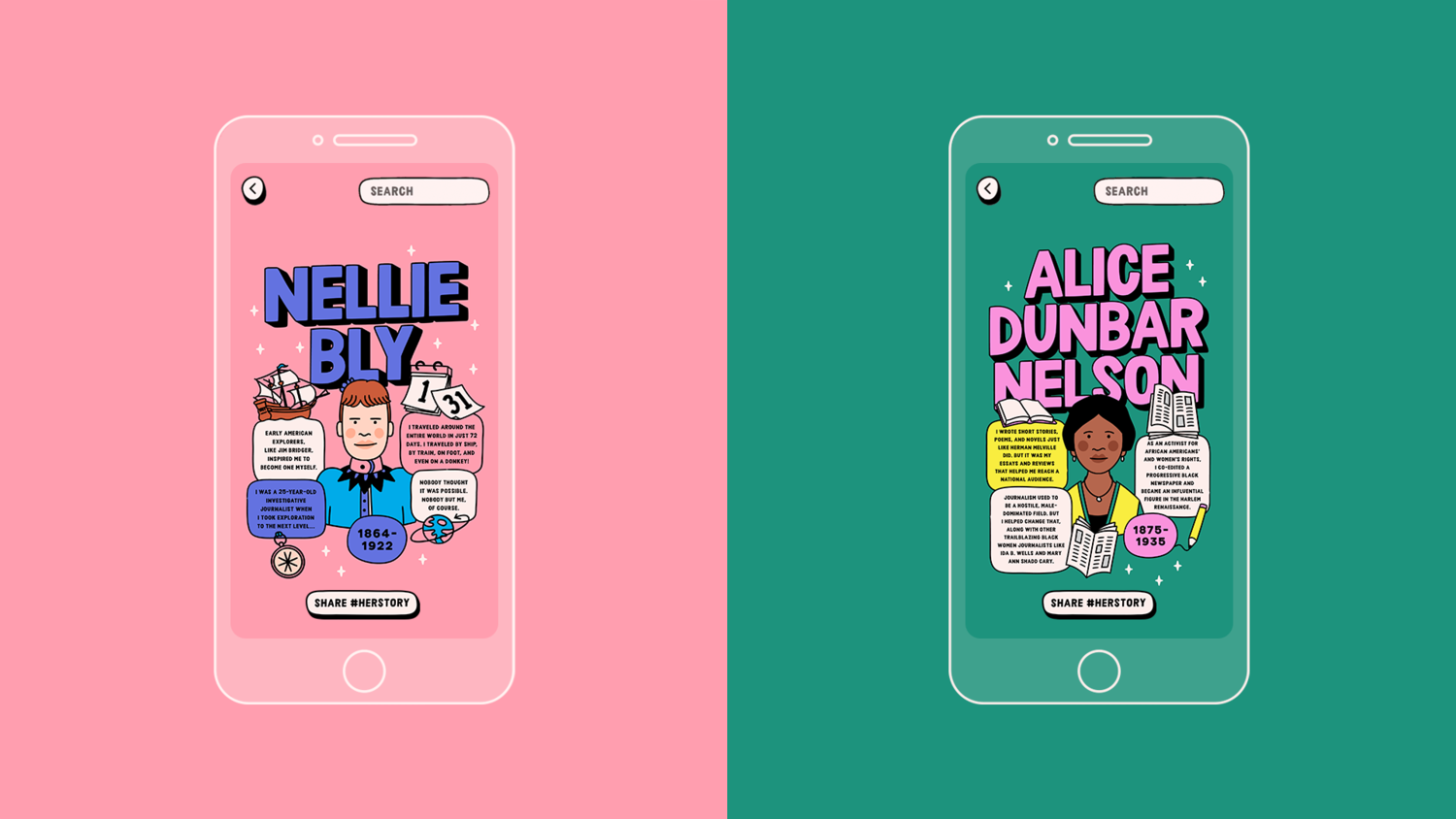[Most Recent Entries] [Calendar View]
Wednesday, April 10th, 2019
| Time | Event |
| 11:00a | New Augmented Reality App Celebrates Stories of Women Typically Omitted from U.S. History Textbooks How do we know if we’ve lived through a major shift toward greater equality? Maybe it’s when history textbooks start telling different stories than the ones they’ve always told about heroes in knee breeches, waistcoats, epaulets, top hats, and beards. Aside from the occasional historical figure in bonnet or bloomers, most texts really have just told “his story.” In the U.S., at least, studies show that only 11% of the stories in history textbooks are about women. Is this because 50% of the population only contributed to 11% percent of the country’s events? No, even the kids know—like the kids in the video above from a new app called Lessons in Herstory—history mostly features men because “a lot of it was written by men and was mostly all about men.” Textbook makers, and the school boards who give them marching orders, may stick to their guns, so to speak, but another major shift could render their dictates irrelevant. Smartphone and tablet technology has become so familiar to today’s kids that instead of turning the pages, they “swipe, like, in the history books,” as one of the youngsters puts it. Students stuck with the old patriarchal pedagogies can easily supplement, enhance, or substitute their education with new media. While there are some serious downsides to this phenomenon, given a distinct lack of quality control online, the internet has also opened up innumerable opportunities for telling the stories of women in history.
Lessons in Herstory, built by an organization called Daughters of the Evolution, takes a unique approach. Instead of supplanting textbooks, it adds to them in an augmented reality smartphone app (currently designed for ios devices) students can point at pictures of historical dudes to pull up stories about a notable women from the same time. Granted, some of these women, like Harriet Tubman and Sacagawea, had already been granted access to the limited space allotted female figures in grade school textbooks. But a great many other people in the app have not. Featuring a diverse selection of 75 herstorical women, Lessons in Herstory is the product of ad agency Goodby Silverstein & Partners’ chief creative officer Margaret Johnson, who launched it at this year’s SXSW. The app has pretty limited application at the moment. It works with one textbook, A History of US, Book 5: Liberty for All? 1820-1860, and with a handful of historical photographs on its website. (Many of the women featured made their mark after 1860.) But with plans to expand and with the backing of a large ad agency, who may or may not have their own designs in marketing Lessons in Herstory, it promises to make women’s history more accessible to students who already spend more time staring at screens than pages.
“There’s a saying,” writes Cara Curtis at The Next Web, “’you can’t be what you can’t see.’” Apps like Lessons in Herstory, along with a number of influential books and websites for young people that narrate the past through the lens of women, indigenous people, African-Americans, artists, activists, working people, and so on, show kids that no matter who they are or where they come from, people who looked like them have always made significant contributions to history. Related Content: Josh Jones is a writer and musician based in Durham, NC. Follow him at @jdmagness New Augmented Reality App Celebrates Stories of Women Typically Omitted from U.S. History Textbooks is a post from: Open Culture. Follow us on Facebook, Twitter, and Google Plus, or get our Daily Email. And don't miss our big collections of Free Online Courses, Free Online Movies, Free eBooks, Free Audio Books, Free Foreign Language Lessons, and MOOCs. |
| 2:00p | A Brief History of IDEO: A Short Documentary Takes You Inside the Design Firm That Changed the Way We Think about Design
The design firm IDEO was founded in 1991, which may not sound like an especially long time ago, but consider it in technological terms: what kind of devices were we using in 1991? How did they look and feel? Chances are not just that the phone and computer you now carry around bear no resemblance to the ones you would have carried around — not that most of them could be carried around — 28 years ago, but that your furniture and household appliances have changed as well. And think, too, of your everyday experiences with shopping, medical care, and government services: some have transformed, usually for the better, and if others haven't, it's probably not a good thing that they've stayed the same. IDEO has worked on the design of products and services in all those fields and others, and has indeed done much to redefine the field of design itself. The company's founders and employees tell the story in their own words in the short documentary video IDEO and a Story of Design above, which focuses on IDEO's achievements in changing the way we think about design (exemplified by the time they redesigned the humble shopping cart on Nightline). And though IDEO as a corporate entity has only existed since the early 1990s, it has deeper roots in the history of design, appearing as it did as a merger of four existing firms, David Kelley Design, ID Two, Matrix Product Design in California, and Moggridge Associates in London. Kelley, who's also a professor at Stanford, appears in the video not only to remember IDEO's founding, but also to talk about its future. So does Tim Brown, who after nineteen years as IDEO's CEO announced last week that he will step down, passing the position on to former global managing director Sandy Speicher. When IDEO enters a world, Speicher says in the video, "we bring our creative lens, imagining how we can make that world better. I'm careful about words like 'solution' or 'the answer,' because these are people-based systems." That remark, as well as the others made by the variety of IDEO people — in a variety of accents befitting a now-global firm with nine locations around the world — provide a glimpse into IDEO's mutually inseparable corporate culture and its conception of design. And if all their talk about reinvention, responsiveness, and asking the big questions sounds a bit high-flown, most of it may come down to an old saying that holds up in every domain just as well today as it did in 1991: There's always room for improvement. Related Content: Free: A Crash Course in Design Thinking from Stanford’s Design School Download 20 Free eBooks on Design from O’Reilly Media Saul Bass’ Advice for Designers: Make Something Beautiful and Don’t Worry About the Money Paola Antonelli on Design as the Interface Between Progress and Humanity Dieter Rams Lists the 10 Timeless Principles of Good Design–Backed by Music by Brian Eno Based in Seoul, Colin Marshall writes and broadcasts on cities, language, and culture. His projects include the book The Stateless City: a Walk through 21st-Century Los Angeles and the video series The City in Cinema. Follow him on Twitter at @colinmarshall or on Facebook. A Brief History of IDEO: A Short Documentary Takes You Inside the Design Firm That Changed the Way We Think about Design is a post from: Open Culture. Follow us on Facebook, Twitter, and Google Plus, or get our Daily Email. And don't miss our big collections of Free Online Courses, Free Online Movies, Free eBooks, Free Audio Books, Free Foreign Language Lessons, and MOOCs. |
| 6:00p | Nick Cave Creates a List of His Top 10 Love Songs 
Nick Cave has been many things in his long, fascinating career—lewd punk-country crooner for the assaultive Birthday Party, prophetic troubadour and Biblical balladeer, founder of the gritty, sleazy Grinderman, novelist and poet of the darker realms of human experience. He has been many things, but sentimental has rarely been one of them, though he can be quite tender and vulnerable. These qualities stand as some of the many reasons I trust Cave to make a list of love songs worth a damn. Not only has he written some of the finest tunes about heartbreak, betrayal, regret, and desire but he has done so with an attitude of reverence for influences like Leonard Cohen and Nina Simone, artists with their own complicated relationships with love. Earlier this year, Cave revealed to readers of his blog The Red Hand Files a selection of his “hiding songs”—music that “I can pull over myself,” he wrote, “like a child might pull the bed covers over their head, when the blaze of the world becomes too intense.” The list includes Dylan’s “It’s All Over Now, Baby Blue,” and Simone’s heartbreakingly somber “Plain Gold Ring.” When Cave is hiding, it ain't in a happy place, but then sad songs usually give us the greatest comfort. Maybe they also offer the best way we have to understand love, “this strange, inscrutable feeling that tears away at us, all our lives,” Cave writes in answer to two of his fans from Australia and Brazil. He leaves them, and us, his list of top ten love songs below. 01. “To Love Somebody” – Bee Gees 02. “My Father” – Nina Simone 03. “I Threw It All Away” – Bob Dylan 04. “Comfort You” – Van Morrison 05. “Angel of the Morning” – Merrilee Rush & The Turnabouts 06. “Nights in White Satin” – The Moody Blues 07. “Where’s the Playground Susie?” – Glen Campbell 08. “Something on Your Mind” – Karen Dalton 09. “Always on My Mind” – Elvis Presley 10. “Superstar” – Carpenters “Maybe some songs are the embodiment of love itself and that’s why they move us so deeply.” No one needs to tell us: love is never easy, and hardly ever just a feeling of euphoria. Like every emotion and experience, it has its melancholy shadows, and the best love songs capture this in their lyrics, chord progressions, etc. The ten love songs Cave chose—“simple, plainspoken, incendiary devices that bomb the heart to pieces”—are all classics from the sixties and seventies, decades he draws from liberally in his “hiding songs” playlist. He favors artists with big personalities, country and folk leanings, and oftentimes a more commercial sound than his own. Nonetheless, those familiar with his music will hear the influence of Elvis, Van Morrison, and maybe even the Bee Gees on his work with the Bad Seeds. He has a new album coming, the follow-up to 2016’s harrowing Skeleton Tree. While we wait to hear what his wife calls “his Fever Songs,” listen to his top ten love songs here. via Brooklyn Vegan Related Content: Listen to Nick Cave’s Lecture on the Art of Writing Sublime Love Songs (1999) Josh Jones is a writer and musician based in Durham, NC. Follow him at @jdmagness Nick Cave Creates a List of His Top 10 Love Songs is a post from: Open Culture. Follow us on Facebook, Twitter, and Google Plus, or get our Daily Email. And don't miss our big collections of Free Online Courses, Free Online Movies, Free eBooks, Free Audio Books, Free Foreign Language Lessons, and MOOCs. |
| << Previous Day |
2019/04/10 [Calendar] |
Next Day >> |












